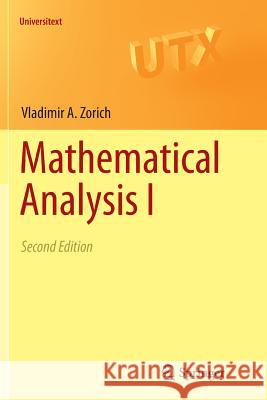Mathematical Analysis I » książka



Mathematical Analysis I
ISBN-13: 9783662569559 / Angielski / Miękka / 2018 / 616 str.
Mathematical Analysis I
ISBN-13: 9783662569559 / Angielski / Miękka / 2018 / 616 str.
(netto: 191,21 VAT: 5%)
Najniższa cena z 30 dni: 192,74
ok. 22 dni roboczych.
Darmowa dostawa!
"This is a thorough and easy-to-follow text for a beginning course in real analysis ... . In coverage the book is slanted towards physics (mostly mechanics), and in particular there is a lot about line and surface integrals. ... Will be popular with students because of the detailed explanations and the worked examples." (Allen Stenger, MAA Reviews, maa.org, May, 2016)
1 Some General Mathematical Concepts and Notation: 1.1 Logical Symbolism.- 1.2 Sets and Elementary Operations on them.- 1.3 Functions.- 1.4 Supplementary Material.- 2 The Real Numbers: 2.1 Axioms and Properties of Real Numbers.- 2.2 Classes of Real Numbers and Computations.- 2.3 Basic Lemmas on Completeness.- 2.4 Countable and Uncountable Sets.- 3 Limits: 3.1 The Limit of a Sequence.- 3.2 The Limit of a Function.- 4 Continuous Functions: 4.1 Basic Definitions and Examples.- 4.2 Properties of Continuous Functions.- 5 Differential Calculus: 5.1 Differentiable Functions.- 5.2 The Basic Rules of Differentiation.- 5.3 The Basic Theorems of Differential Calculus.- 5.4 Differential Calculus Used to Study Functions.- 5.5 Complex Numbers and Elementary Functions.- 5.6 Examples of Differential Calculus in Natural Science.- 5.7 Primitives.- 6 Integration: 6.1 Definition of the Integral.- 6.2 Linearity, Additivity and Monotonicity of the Integral.- 6.3 The Integral and the Derivative.- 6.4 Some Applications of Integration.- 6.5 Improper Integrals.- 7 Functions of Several Variables: 7.1 The Space Rm and its Subsets.- 7.2 Limits and Continuity of Functions of Several Variables.- 8 Differential Calculus in Several Variables: 8.1 The Linear Structure on Rm.- 8.2 The Differential of a Function of Several Variables.- 8.3 The Basic Laws of Differentiation.- 8.4 Real-valued Functions of Several Variables.- 8.5 The
Implicit Function Theorem.- 8.6 Some Corollaries of the Implicit Function Theorem.- 8.7 Surfaces in Rn and Constrained Extrema.- Some Problems from the Midterm Examinations: 1. Introduction to Analysis (Numbers, Functions, Limits).- 2. One-variable Differential Calculus.- 3. Integration. Introduction to Several Variables.- 4. Differential Calculus of Several Variables.- Examination Topics: 1. First Semester: 1.1. Introduction and One-variable Differential Calculus.- 2. Second Semester: 2.1. Integration. Multivariable Differential Calculus.- Appendices: A Mathematical Analysis (Introductory Lecture).- B Numerical Methods for Solving Equations (An Introduction).- C The Legendre Transform (First Discussion).- D The Euler–Maclaurin Formula.- E Riemann–Stieltjes Integral, Delta Function, and Generalized Functions.- F The Implicit Function Theorem (An Alternative Presentation).- References.- Subject Index.- Name Index.VLADIMIR A. ZORICH is professor of mathematics at Moscow State University. His areas of specialization are analysis, conformal geometry, quasiconformal mappings, and mathematical aspects of thermodynamics. He solved the problem of global homeomorphism for space quasiconformal mappings. He holds a patent in the technology of mechanical engineering, and he is also known by his book “Mathematical Analysis of Problems in the Natural Sciences”.
VLADIMIR A. ZORICH is professor of mathematics at Moscow State University. His areas of specialization are analysis, conformal geometry, quasiconformal mappings, and mathematical aspects of thermodynamics. He solved the problem of global homeomorphism for space quasiconformal mappings. He holds a patent in the technology of mechanical engineering, and he is also known by his book Mathematical Analysis of Problems in the Natural Sciences .
This second English edition of a very popular two-volume work presents a thorough first course in analysis, leading from real numbers to such advanced topics as differential forms on manifolds; asymptotic methods; Fourier, Laplace, and Legendre transforms; elliptic functions; and distributions. Especially notable in this course are the clearly expressed orientation toward the natural sciences and the informal exploration of the essence and the roots of the basic concepts and theorems of calculus. Clarity of exposition is matched by a wealth of instructive exercises, problems, and fresh applications to areas seldom touched on in textbooks on real analysis.
The main difference between the second and first English editions is the addition of a series of appendices to each volume. There are six of them in the first volume and five in the second. The subjects of these appendices are diverse. They are meant to be useful to both students (in mathematics and physics) and teachers, who may be motivated by different goals.
Some of the appendices are surveys, both prospective and retrospective. The final survey establishes important conceptual connections between analysis and other parts of mathematics.The first volume constitutes a complete course in one-variable calculus along with the multivariable differential calculus elucidated in an up-to-date, clear manner, with a pleasant geometric and natural sciences flavor.
“...Complete logical rigor of discussion...is combined with simplicity and completeness as well as with the development of the habit to work with real problems from natural sciences. ” From a review by A.N. Kolmogorov of the first Russian edition of this course
“...We see here not only a mathematical pattern, but also the way it works in the solution of nontrivial questions outside mathematics. ...The course is unusually rich in ideas and shows clearly the power of the ideas and methods of modern mathematics in the study of particular problems....In my opinion, this course is the best of the existing modern courses of analysis.” From a review by V.I.Arnold
1997-2026 DolnySlask.com Agencja Internetowa
KrainaKsiazek.PL - Księgarnia Internetowa









